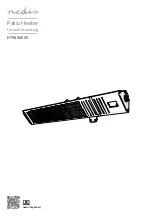
JANUARY 2014
page 8
www.fisherstoves.co.nz
The long-burning fire:
To achieve a long burning fire, rake the embers evenly, as with the small hot fire, and
use larger and more pieces of wood. Place the pieces in a similar pattern to the small hot fire, using more
pieces and larger pieces (especially the top layer).
Always make certain that there is a gap between the
pieces to ensure that the combustion air can reach all pieces.
Open the air inlets fully for between 15 to
0 minutes depending on load size and fuel moisture content. When the fire is burning fiercely (at least 15
minutes), reduce the air control in stages to the desired level. This allows you to turn down the air control and
still maintain a clean-burning fire.
rememBer: NeVer LeT The Fire smOuLDer.
preventing creosote build-up:
Creosote is a tar-like substance that builds up when the organic
compounds in smoke condense onto cooler flue surfaces. Left to build up over time, creosote will restrict the
airflow of the flue and impair the performance of your heater. The production of smoke is at its highest when
a fresh fuel load is added or when the air control is at its lowest position. The most effective way to control
the creosote formation is to burn the heater so as to ensure as complete combustion as possible and at the
same time promoting higher flue temperatures. Smoldering fires should always be avoided.
The amount of charcoal in the ash is often a good indicator of how well you are operating the heater.
If there is no charcoal and only very fine ash, then you are doing an excellent job. If there is a lot of
charcoal you may be turning the combustion air down too soon after re-fuelling, or not raking the charcoal
to the combustion air inlet, or turning the combustion air down too low to support efficient combustion,
or all of the above.
rememBer: The hOTTer The Fire, The Less CreOsOTe FOrmATiON.
When you have mastered the techniques for efficient wood burning, here is what you should see:
1.
When wood burns it should be flaming until only charcoal remains. If there are no
flames, something is wrong.
2.
Firebricks in the firebox should be tan in colour, never black.
3.
Steel parts in the firebox should be light to dark brown, never black and shiny.
4.
With seasoned wood, correct air settings and proper loading arrangement you should
expect quick ignition of a new load of wood - the bottom pieces should be flaming by
the time the door is closed.
5.
The glass door should be clear. A discoloured glass indicates that the wood is too wet
or the air control has not been left open long enough.
6.
The exhaust coming from the top of the flue system should be clear or white. A plume
of blue or grey smoke indicates smouldering, inefficient combustion, air pollution and
probably low operating temperatures.

































